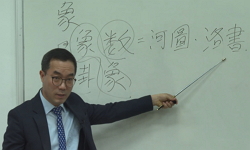This study makes an objection to a viewpoint of interpreting Jogakbo as women's skill, theoutcome of thrift and saving, or as projection of women's life of deep sorrow. This studynumerically analyzed hado and nakseo that become the basis of Yin-yang &...
http://chineseinput.net/에서 pinyin(병음)방식으로 중국어를 변환할 수 있습니다.
변환된 중국어를 복사하여 사용하시면 됩니다.
- 中文 을 입력하시려면 zhongwen을 입력하시고 space를누르시면됩니다.
- 北京 을 입력하시려면 beijing을 입력하시고 space를 누르시면 됩니다.

조각보에 내재된 음양오행에 대한 연구 : 하도와 낙서를 중심으로 = A study on Yin-Yang Five Elements Inherent in Jogakbo : Focusing on Hado and Naksu
한글로보기부가정보
다국어 초록 (Multilingual Abstract)
This study makes an objection to a viewpoint of interpreting Jogakbo as women's skill, theoutcome of thrift and saving, or as projection of women's life of deep sorrow. This studynumerically analyzed hado and nakseo that become the basis of Yin-yang & five elements of theuniverse and figured out the logic of the number. This study produced an image that hado andnakseo represent and empirically analyzed how it was projected on Jogakbo around relics of the19th century. The results are as follows. First, hado is the principle of generation of all thingsand gets replaced into an image called taegeuk through the mathematical principle. Taegeukwith five colors expresses circulation with a positive color blue and negative color red, andcomposition and arrangement of colors that coincide with the principle of taegeuk wereidentified in Jogakbo. Secondly, nakseo is the principle of circulation of all things and getsreplaced into an image of 3 mabangjin through the mathematical principle. This study extracted4 types as a basic type, rotating type, up-and-down type, and radial type, and identified ogakbothat correspond to these types. Thirdly, this study extracted 4 types as cross type, quadrangularpyramid type, wave type, and checkerboard type by interpreting cheonjibokjaedo of badukcreated by adding the number of hado 10 and the number of nakseo 9, and identified Jogakbothat correspond to these types. It was verified that patchworks of the Joseon Dynasty period areof the principle of Yin-yang & five elements of the universe that people of the time held on toand is the 'text' that contains the principle of creation and circulation of universe rather than thecombination of shapes.
국문 초록 (Abstract)
본 연구는 지금까지 조각보를 해석함에 있어서 여인들의 솜씨나 근검절약의 결과물 또는 여인들의 한을 담아낸 삶의 투영으로 보는 관점에 이의를 제기한다. 본 연구에서는 먼저 조선시대 ...
본 연구는 지금까지 조각보를 해석함에 있어서 여인들의 솜씨나 근검절약의 결과물 또는 여인들의 한을 담아낸 삶의 투영으로 보는 관점에 이의를 제기한다. 본 연구에서는 먼저 조선시대 사람들 속에 내재하고 있는 사상적 원형인 음양오행 원리의 근본이 되는 하도와 낙서를 수리적으로 분석하고 그 수가 가진 이치를 파악하였다. 수의 이치를 통해 하도와 낙서가 가리키는 상(象)을 도출하여 그것이 조각보에 어떻게 투영되었는지를 19세기 유물을 중심으로 실증적으로 분석하였다. 그리하여 다음과 같은 결과를 얻게 되었다. 첫째 하도는 만물의 생성원리이며 그 수리를 통해 태극이라는 상으로 치환된다. 오방색이 적용된 태극은 음색인 파랑과 양색인 빨강으로 순환을 표현하고있는데 조각보에서 태극의 상과 일치하는 구성과 배색을 확인할 수 있었다. 둘째, 낙서는 만물의 순환원리이며 그수리를 통해 3마방진의 상으로 치환된다. 3마방진으로부터 기본형, 회전형, 오른내림형, 방사형의 4가지 유형을추출하였고, 이 유형에 부합하는 조각보들을 확인할 수 있었다. 셋째, 하도의 수 10과 낙서의 수 9가 더해져 만들어진 바둑의 천지복재도를 3마방진의 확장인 19마방진으로 해석하여 십자형, 사각뿔형, 파문형, 바둑판형의 4가지 유형을 추출하였고 이에 부합하는 조각보들을 확인할 수 있었다. 이로써 조선시대 조각보는 당대 사람들이 견지해 온 음양오행의 원리를 담은 것으로서 도형의 조합이기보다 우주의 생성과 순환의 원리를 담은 ‘텍스트’라는것을 알 수 있다.
참고문헌 (Reference)
1 김윤식, "하도·낙서·천부삼인" 한국학술정보(주) 2012
2 이선재, "조선시대 복식에 반영된 음양오행사상에 관한 연구" 31 : 1992
3 야나기 무네요시, "전집 18" 1959
4 허동화, "이렇게 예쁜 보자기" 한국자수박물관 출판부 2004
5 소재학, "음양오행의 원리이해" 하원정 2009
6 양계초, "음양오행설의 연구" 신지서원 1993
7 허동화, "우리가 정말 알아야 할 우리 규방 문화" 현암사 1997
8 허동화, "우리 옛 보자기의 아름다움"
9 임병학, "역학과 하도낙서" 한국학술정보(주) 2008
10 문용직, "바둑의 발견" 부키 2005
1 김윤식, "하도·낙서·천부삼인" 한국학술정보(주) 2012
2 이선재, "조선시대 복식에 반영된 음양오행사상에 관한 연구" 31 : 1992
3 야나기 무네요시, "전집 18" 1959
4 허동화, "이렇게 예쁜 보자기" 한국자수박물관 출판부 2004
5 소재학, "음양오행의 원리이해" 하원정 2009
6 양계초, "음양오행설의 연구" 신지서원 1993
7 허동화, "우리가 정말 알아야 할 우리 규방 문화" 현암사 1997
8 허동화, "우리 옛 보자기의 아름다움"
9 임병학, "역학과 하도낙서" 한국학술정보(주) 2008
10 문용직, "바둑의 발견" 부키 2005
11 김석진, "대상주역강의 상경" 도서출판 한길사 1999
12 김종길, "易學에서 九宮의 活⽤樣相 硏究" 동방문화대학원대학교 2016
13 왕선의, "三易 해인의 신비" 진한엠앤비 2012
14 Huh Dong-hwa, "Crafts of the Inner Court" The Museum of Embroidery 1987
동일학술지(권/호) 다른 논문
-
- 한국기초조형학회
- 이려
- 2018
- KCI등재
-
아동 교과서 이미지에 함의된 가족 이데올로기 연구 -10~13세 도덕교과서 사례의 기호학적 분석을 중심으로-
- 한국기초조형학회
- 이은주
- 2018
- KCI등재
-
황금비를 활용한 학제적 융합 미술수업 방안과 구현가능성에 관한 연구
- 한국기초조형학회
- 신현용
- 2018
- KCI등재
-
전통시장 이용자 의식 향상을 위한 지원방향에 대한 연구 -천안 남산 중앙시장을 중심으로-
- 한국기초조형학회
- 안미경
- 2018
- KCI등재
분석정보
인용정보 인용지수 설명보기
학술지 이력
| 연월일 | 이력구분 | 이력상세 | 등재구분 |
|---|---|---|---|
| 2027 | 평가예정 | 재인증평가 신청대상 (재인증) | |
| 2021-01-01 | 평가 | 등재학술지 유지 (재인증) |  |
| 2018-01-01 | 평가 | 등재학술지 유지 (등재유지) |  |
| 2015-02-09 | 학술지명변경 | 외국어명 : Bulletin of Korean Society of Basic Design & Art -> Journal of Basic Design & Art |  |
| 2015-01-01 | 평가 | 등재학술지 유지 (등재유지) |  |
| 2011-01-01 | 평가 | 등재학술지 유지 (등재유지) |  |
| 2009-01-01 | 평가 | 등재학술지 유지 (등재유지) |  |
| 2006-01-01 | 평가 | 등재학술지 선정 (등재후보2차) |  |
| 2005-01-01 | 평가 | 등재후보 1차 PASS (등재후보1차) |  |
| 2003-01-01 | 평가 | 등재후보학술지 선정 (신규평가) |  |
학술지 인용정보
| 기준연도 | WOS-KCI 통합IF(2년) | KCIF(2년) | KCIF(3년) |
|---|---|---|---|
| 2016 | 0.33 | 0.33 | 0.34 |
| KCIF(4년) | KCIF(5년) | 중심성지수(3년) | 즉시성지수 |
| 0.34 | 0.34 | 0.512 | 0.08 |




 KCI
KCI DBpia
DBpia




